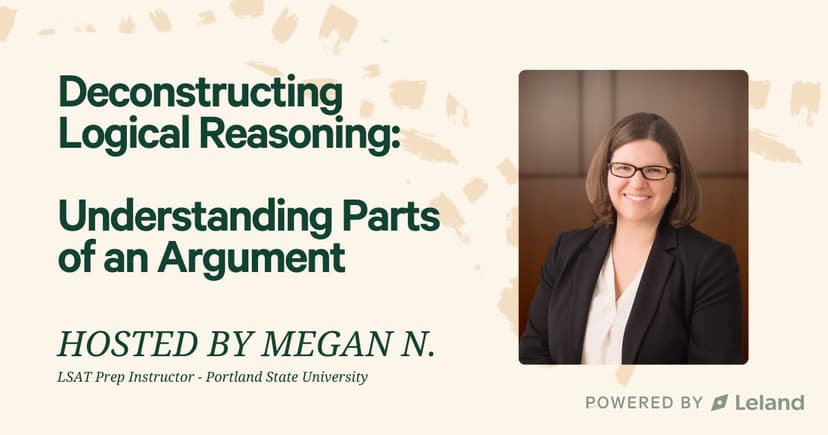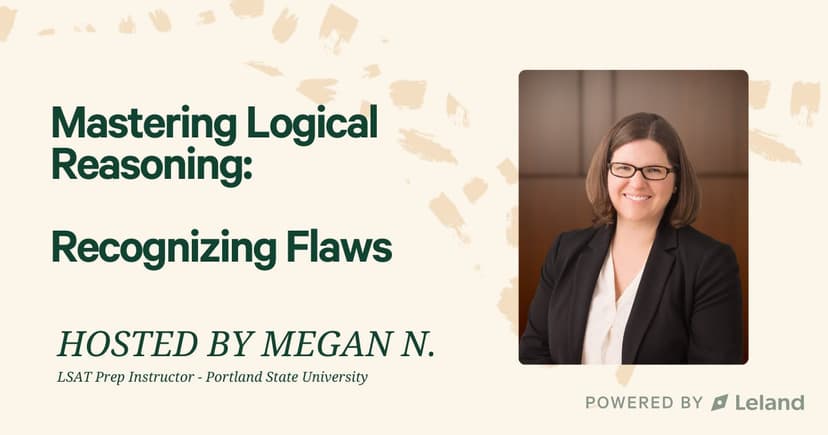Weakness & Strengthen Questions: An LSAT Tutor's Guide
Learn how to read, analyze, and ace strengthen and weakness questions on the LSAT with custom tips and strategies from a professional tutor who scored in the 99th percentile on the exam.

By Eshaan S.
99th Percentile Experienced Tutor w/ Proven Results!
Posted June 13, 2025

Join a free event
Learn from top coaches and industry experts in live, interactive sessions you can join for free.
Table of Contents
Struggling with strengthen and weaken questions on the LSAT? You're not alone. These Logical Reasoning question types appear frequently – and they can tank your score if you don’t know how to approach them strategically.
As a 99th percentile scorer on multiple graduate exams, including a 175 on the LSAT, I have been helping students excel on the LSAT since 2020. I specialize in guiding students through custom strategies to overcome score plateaus and achieve their target results. My approach is defined by personalization and dedication, ensuring that each student's unique strengths and weaknesses are addressed.
This guide provides a comprehensive approach to tackling these question types, focusing on practical strategies, key insights, and techniques to improve accuracy and confidence. Deciding whether to take the LSAT or GRE? This guide can help. Without ado, let's jump in.
Read: How Important is the LSAT for Law School Admission?
What Are Strengthen and Weaken Questions?
Strengthen and weaken questions ask test-takers to evaluate an argument’s conclusion and determine how to either support or challenge it. Strengthen questions ask you to identify new evidence that makes the conclusion more likely to be true, while weaken questions require you to spot flaws, introduce alternative explanations, or otherwise cast doubt on the argument’s validity.
Both types hinge on your ability to break down the argument’s structure: spotting the conclusion, identifying the premises that support it, and uncovering the assumptions that link them together.
How to Identify Strengthen and Weaken Questions
You can usually spot strengthen and weaken questions by the language used in the prompt. These questions will explicitly ask you to support or undermine the argument. Look for key verbs like:
- Strengthen questions often include: “support,” “strengthen,” “justify,” or “bolster”
- Weaken questions often include: “weaken,” “undermine,” “cast doubt,” or “counter”
LSAT Strengthen Question Examples:
- Which one of the following, if true, most strongly supports the argument above?
- Which one of the following, if true, most strengthens the archaeologist’s conclusion?
- Which one of the following, if true, provides the most support for the hypothesis?
LSAT Weaken Question Examples:
- Which one of the following, if true, most seriously undermines the argument?
- Which one of the following, if true, casts the most doubt on the reasoning above?
- Which one of the following represents the strongest counter to the policy analyst’s reasoning?
Expert Tip: Pay close attention to the wording of the question stem. It tells you exactly what your task is, and misunderstanding it is one of the most common reasons students miss these questions.
Example Question Breakdown
Before we get much further, let’s go through an example so you know what we’re dealing with here. Here’s a very classic LSAT weaken question.
- Stimulus: A recent study found that people who regularly consume caffeinated beverages have a lower risk of developing a certain chronic disease. The study concludes that consuming caffeine reduces the risk of this disease.
- Question Stem: Which one of the following, if true, most seriously weakens the argument?
- Answer Choices:
- (A) The study did not control for other lifestyle factors, such as diet and exercise, that could also affect the risk of developing the disease.
- (B) The study found that decaffeinated beverages do not have the same effect on disease risk as caffeinated ones.
- (C) Participants in the study who consumed caffeinated beverages also consumed a higher-than-average amount of antioxidants.
- (D) The chronic disease mentioned in the study has many known causes, including genetic factors.
- (E) Some participants in the study reported consuming caffeine only sporadically.
Expert Analysis
The unstated assumption in the argument’s conclusion is that caffeine itself reduces the risk of the disease. The “link” between the evidence provided (a recent study’s results) and the author’s conclusion (consuming caffeine reduces disease risk) is the assumption that caffeine caused less people to develop the disease. To weaken this conclusion, therefore, we need an answer that introduces doubt about whether caffeine is the actual cause. The best answer is (A) because this choice highlights that other factors, such as diet and exercise, were not accounted for. This undermines the argument's validity by introducing alternative explanations.
How to Ace Strengthen & Weakness Questions
To answer strengthen or weaken questions on the LSAT, first identify the conclusion, premises, and unstated assumptions in the argument. Then, choose the answer that either reinforces the assumption (strengthen) or introduces a plausible alternative explanation (weaken). Avoid answers that are outside the argument’s scope. Let’s go through these one-by-one.
1. Dissect the Argument Structure: Conclusion, Premises, Assumptions
Every strengthen or weaken question hinges on a clearly defined argument. Start by identifying:
- Conclusion: What is the author trying to prove? (This is often where the argument implies a definitive position.)
- Premises: What evidence are they using to support it?
- Assumptions: What’s the unstated link between the two? What does the argument rely on in order to hold true?
Example: People who drink green tea have lower rates of heart disease. Therefore, drinking green tea prevents heart disease.
- Conclusion: Green tea prevents heart disease
- Premise: Green tea drinkers have lower heart disease rates
- Assumption: There’s no other explanation for the correlation (e.g., lifestyle, genetics)
Recognizing this causal assumption, especially, makes it much easier to predict a strong weaken or strengthen answer.
2. Evaluate Answer Choices Based on Their Impact
Once you’ve mapped the argument, approach each answer by asking: Does this affect the assumption or the link between evidence and conclusion? It's vital to remember that not all of them are equally plausible. The correct answer word or phrase in a strengthen question will add support, while in a weaken question, it will hurt the argument by casting doubt or providing counterexamples.
Eliminate:
- Answers that are out of scope (don’t relate to the key reasoning)
- Neutral facts that neither help nor hurt the argument
- Answers that only affect a side issue (like the size of the study or tone of the conclusion)
Favor:
- Answers that test or reinforce the core assumption
- Those that introduce alternative explanations (weaken)
- Or rule out alternative explanations (strengthen)
Example: Green tea drinkers in the study also exercised significantly more than non-tea drinkers.
- This introduces an alternative cause for the health outcome, directly challenging the original causal assumption. That’s classic weaken logic.
3. Use the Process of Elimination (Aggressively)
When in doubt, eliminate answers that don’t interact directly with the argument. Even strong test-takers often get these wrong by picking “plausible but irrelevant” choices. Answer elimination is one of the best strategies for these types of questions.
- Start with eliminating vague or extreme language like “always,” “never,” “completely,” “guaranteed.”
- Then, go to out-of-scope issues where new variables are introduced that aren’t referenced in the stimulus.
- Lastly, remove any answer options that mischaracterize the conclusion or focus on irrelevant premises.
Expert Tip: If you're stuck between two answer choices, reframe the assumption in your own words, then ask which answer choice most directly hits it.
Additional Expert Strategies
Strengthen Questions
With these questions, your goal is to make the conclusion more likely by reinforcing the assumption.
Common Pattern #1: Rule out alternative causes
- Stimulus: Children who eat breakfast every day tend to perform better in school than those who do not. Therefore, eating breakfast improves academic performance.
- Question Stem: Which one of the following, if true, most strengthens the argument?
- Answer Options:
- (A) Children who eat breakfast also tend to get more hours of sleep than those who don’t.
- (B) Most children who skip breakfast also skip lunch.
- (C) Children from households that emphasize breakfast are more likely to have strong academic support at home.
- (D) Children who eat breakfast daily do not differ significantly from non-breakfast-eaters in terms of sleep habits, parental involvement, or access to academic support.
- (E) Many children who skip breakfast report feeling hungry during the school day.
Analysis:
- Conclusion: Eating breakfast → better academic performance
- Premise: Breakfast-eaters perform better than non-breakfast-eaters
- Assumption: There’s no other relevant difference between the two groups
Correct Answer: (D) Children who eat breakfast daily do not differ significantly from non-breakfast-eaters in terms of sleep habits, parental involvement, or access to academic support.
- This answer rules out alternative explanations, reinforcing the idea that breakfast itself is responsible for the outcome. It strengthens the causal link by eliminating other variables.
Common Pattern #2: Provide more evidence linking cause to effect
- Stimulus: A recent study found that people who take a daily walk report lower stress levels than those who don’t. The study’s authors concluded that walking reduces stress.
- Question Stem: Which one of the following, if true, most strengthens the argument?
- Answer Options:
- (A) Participants who walked more than once per day reported even lower stress levels than those who walked once per day.
- (B) Participants who began a daily walking routine during the study reported a noticeable decrease in stress compared to their baseline stress levels.
- (C) People who walk daily are more likely to practice meditation or yoga than those who don’t.
- (D) Some participants walked only on weekdays, not weekends.
- (E) Many people in the study reported enjoying walking as a form of leisure activity.
Analysis:
- Conclusion: Walking reduces stress
- Premise: Walkers report lower stress levels than non-walkers
- Assumption: Walking itself is responsible for the reduced stress, not other factors like personality, routine, or lifestyle
Correct Answer: (B) Participants who began a daily walking routine during the study reported a noticeable decrease in stress compared to their baseline stress levels.
- This answer shows a clear before-and-after improvement within the same individuals, establishing a causal link between walking and reduced stress. That directly strengthens the claim that walking – and not some external factor – is the reason for the difference in stress levels.
Common Pattern #3: Confirm that the sample or data is representative
- Stimulus: In a recent survey, 85% of people polled said they prefer shopping online to shopping in physical stores. Therefore, most consumers now prefer online shopping.
- Question Stem: Which one of the following, if true, most strengthens the argument?
- Answer Options:
- (A) Many people who prefer shopping online also shop at physical stores occasionally.
- (B) The survey was conducted online, which may have influenced respondents’ preferences.
- (C) The survey was conducted during a time of increased COVID-19 restrictions on in-person shopping.
- (D) The survey included a demographically balanced, random sample of consumers from all age groups, income levels, and regions.
- (E) People who prefer physical stores often cite the ability to see and touch products before buying.
Analysis:
- Conclusion: Most consumers now prefer online shopping
- Premise: 85% of surveyed people said they prefer shopping online
- Assumption: The survey sample accurately represents the broader population of consumers
Correct Answer: (D) The survey included a demographically balanced, random sample of consumers from all age groups, income levels, and regions.
- The argument draws a broad conclusion based on survey data. To strengthen it, we need to ensure that data is trustworthy and generalizable. This answer confirms the sample is representative, which increases the validity of applying the result to “most consumers.”
Weakness Questions
Common Pattern #1: Introduce an alternative cause
- Stimulus: A recent study found that students who regularly use standing desks tend to have higher test scores than those who don’t. Therefore, standing desks improve academic performance.
- Question Stem: Which one of the following, if true, most seriously weakens the argument?
- Answer Options:
- (A) Students who use standing desks report feeling more energetic during the day.
- (B) Some students reported discomfort after long periods of standing.
- (C) Schools that use standing desks tend to have smaller class sizes and more experienced teachers.
- (D) Students who used standing desks were surveyed about their academic goals.
- (E) Standing desks have become more common in classrooms in recent years.
Analysis:
- Conclusion: Standing desks improve academic performance
- Premise: Standing desk users scored higher than non-users
- Assumption: The desks, and not other factors, caused the performance boost
Correct Answer: (C) Schools that use standing desks tend to have smaller class sizes and more experienced teachers.
- This introduces a plausible alternative cause: students might be performing better because of better learning environments, not the desks. That weakens the argument by undermining the link between standing desks and academic outcomes.
Common Pattern #2: Undermine the data or study
- Stimulus: A recent poll found that 70% of employees at TechCorp reported higher job satisfaction after the company implemented a four-day workweek. Therefore, the four-day workweek caused the improvement in satisfaction.
- Question Stem: Which one of the following, if true, most seriously undermines the reasoning above?
- Answer Options:
- (A) Many employees expressed interest in continuing the four-day schedule in the future.
- (B) Some employees were unaware that the four-day schedule was a pilot program.
- (C) Employees at other companies with four-day workweeks also reported increased satisfaction.
- (D) The company saw a slight decrease in productivity after the schedule change.
- (E) The poll was conducted by TechCorp’s HR department and did not include anonymous responses.
Analysis:
- Conclusion: The four-day workweek improved job satisfaction
- Premise: 70% reported higher satisfaction after the change
- Assumption: The data is valid and the increase is due to the schedule itself
Correct Answer: (E) The poll was conducted by TechCorp’s HR department and did not include anonymous responses.
- If the responses weren’t anonymous, employees may have felt pressure to respond positively, making the data unreliable. That undermines the foundation of the argument and weakens the conclusion.
Common Pattern #3: Show the outcome could’ve occurred anyway
- Stimulus: After City A installed more public recycling bins, recycling rates increased by 20%. Officials concluded that installing bins directly caused the improvement.
- Question Stem: Which one of the following, if true, most undermines the reasoning above?
- Answer Options:
- (A) The recycling rate in City A had already been increasing steadily before the bins were installed.
- (B) Many residents in City A reported that the new bins were more convenient to access.
- (C) City B installed similar bins but saw no significant change in recycling rates.
- (D) A recent marketing campaign in City A promoted the environmental benefits of recycling.
- (E) Some residents continued to recycle at home rather than using public bins.
Analysis:
- Conclusion: Installing bins caused the increase in recycling
- Premise: Recycling rates rose after bins were installed
- Assumption: The bin installation was the primary cause – not part of a preexisting trend
Correct Answer: (A) The recycling rate in City A had already been increasing steadily before the bins were installed.
- This shows the improvement might have happened regardless of the bins, weakening the causal link. If rates were already rising, the timing of the bins could be a coincidence, not the cause.
Common Traps and How to Avoid Them
When tackling LSAT strengthen and weaken questions, it’s essential to recognize common pitfalls that can lead to incorrect answers. Here are the traps to watch for that I see the most often, and my strategies to avoid them:
- Extreme wording – Be cautious of answers that include absolute terms such as "always," "never," or "must." These words often misrepresent the flexibility of the argument or exaggerate its implications, making these choices unlikely to be correct. Focus on answer choices that use balanced and reasonable language.
- Irrelevant information – Eliminate answers that introduce evidence or points beyond the argument’s scope, the specific world described by the author’s conclusion. These distractors may seem plausible but fail to engage with the argument directly. Remember, an answer choice weakens the argument only if it challenges its validity or assumptions.
- Confusing premises with conclusion – Ensure that you correctly identify the argument's conclusion before evaluating the answer choices. This is an extremely common mistake I notice students make, and it’s because they are not crystal-clear about what defines a conclusion vs. a premise. Misunderstanding the conclusion can lead you to select an answer that strengthens or weakens a premise instead of addressing the main argument.
- Misleading comparisons – Avoid answer choices that introduce comparisons to unrelated scenarios. For instance, an argument discussing five answers should not be influenced by an unrelated hypothetical scenario involving a different scope (e.g. “In another industry…” or “In a different city…”). Always evaluate choices within the argument's original framework.
- Answer choices with partial relevance – Be wary of answers that seem partially correct but do not fully strengthen or weaken the argument. These options might address some aspects of the premises but fail to engage with the argument’s main conclusion or assumptions.
- Overgeneralization – Avoid answers that rely on broad generalizations or unsupported claims. These often lack the specificity needed to strengthen or weaken the argument effectively. Choose answers that precisely target the argument's reasoning by introducing a fact that is relevant to the scope of the author’s argument.
- Ignoring alternative explanations – For weaken questions, consider whether the answer introduces opposing viewpoints that challenge the argument’s assumptions. For instance, an argument made by opposing counsel might undermine the original conclusion by providing a valid counterargument or highlighting a flaw in reasoning.
- Failure to address logical gaps – Both strengthen and weaken questions often hinge on recognizing gaps in reasoning. Ensure that the answer you select directly addresses these gaps instead of providing tangential or unrelated information.
The Bottom Line
Strengthen and weaken questions are some of the most important – and most missed – on the LSAT. But once you understand how arguments work, how assumptions function, and how to test them, these questions become a lot more predictable (and even kind of fun).
If you're still getting tripped up or unsure why certain answers are wrong, you're not alone. These take practice, pattern recognition, and feedback to master, and that’s exactly what I help my students do every day.
Want help working through these? You can book a free intro call with me here. I’ll help you break down the logic, fix what’s holding you back, and build a custom plan to hit your target LSAT score.
Read these next:
- LSAC GPA and Its Impact on Law School Admissions
- How Many Law Schools Should You Apply To?
- LSAC Credential Assembly Service (CAS): What it Is and How It Works for Law School Applications
- How to Write a Powerful Personal Statement for Your Law School Applications
- T14 Law Schools: Acceptance Rates & Class Profiles
FAQs
How to approach weaken questions?
- For weaken questions, you're looking to make the conclusion less likely to occur, and the central assumption less likely to be true. The answer will offer additional facts that make the conclusion less likely to follow.
How to quickly improve logical reasoning in LSAT?
- You should concern yourself with digesting the stimulus fully and accurately, diagramming conditional statements, prephrasing every answer, sorting answers into losers and contenders quickly, and using question techniques when necessary (like the Negation Technique for Assumptions).
How do you solve the most strongly supported questions on the LSAT?
- To approach "Most Strongly Supported" questions on the LSAT, start by getting a thorough understanding of the passage, and treating every statement as true within the context provided. Predict a possible answer before looking at the options, using the passage's information to infer what else must be true.
Is Logical Reasoning (LR) the hardest part of the LSAT?
- It truly depends on the person. The Logical Reasoning section of the LSAT proved to be the most challenging LSAT section for me, however, applying strategies and techniques in the Reading Comprehension section felt more intuitive . Although the right prep strategy really helped me tackle this difficult part of the exam, it really presented me with its own set of challenges and rewards.
How to get better at strengthen and weaken questions in LSAT?
- To excel on strengthen/weaken questions on the LSAT, it's critical to be able to identify assumptions and flaws in arguments. Assumptions are unstated premises that underlie an argument, and identifying them can be key to understanding how the argument works and how it could be strengthened or weakened.
How to weaken a causal argument in LSAT?
- The best way to weaken a causal argument is to suggest an alternative causal factor. (A) Parents stock up on cold medicine that alleviates the symptoms of a cold after a child gets sick. This choice presents another possible reason to undermine the argument, but the medicine deals with symptoms, not the cold per se.

Written by Eshaan
4.8
(21)
Eshaan has helped clients get into organizations like:
Browse hundreds of expert coaches
Leland coaches have helped thousands of people achieve their goals. A dedicated mentor can make all the difference.
















